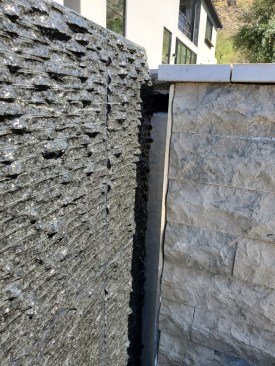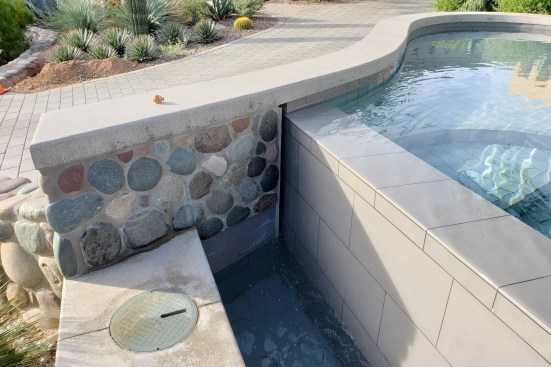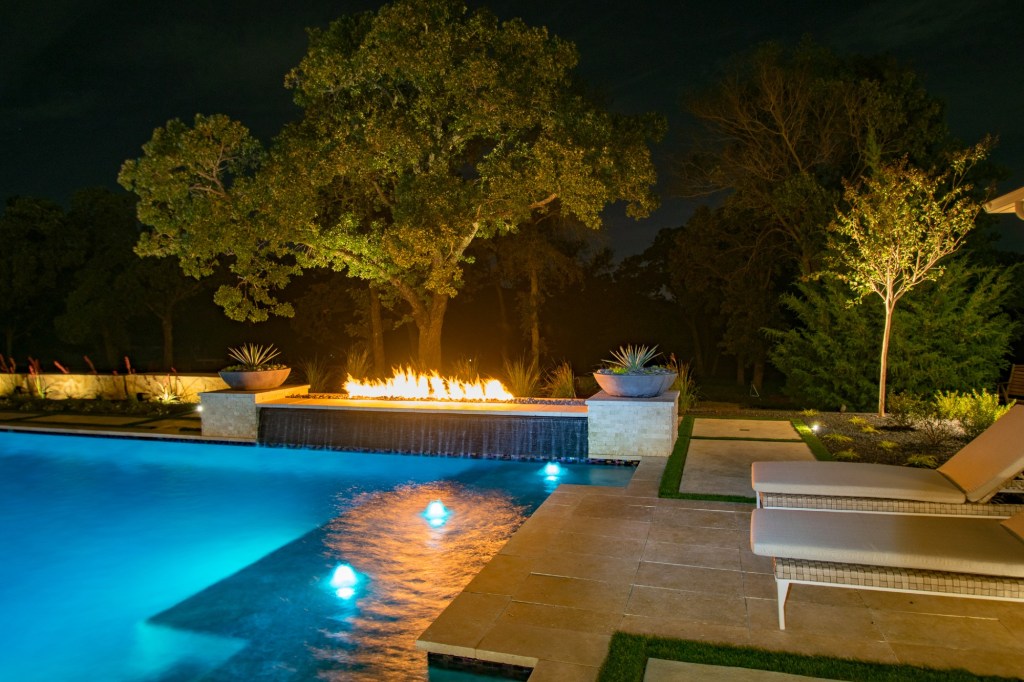Water is a powerful force and a wily substance. It can melodically trickle down in a gentle stream and it can erode mountains through its movement.
“The most important thing to know is water rarely does what you think it’s going to do,” says Rick Chafey, co-owner and founder of Red Rock Contractors and Red Rock Pools & Spas, in Chandler, Ariz. “We presume a number of things, but it’s the weirdest material. ”
Its chemistry can impact the materials and surfaces around it. When you add movement to the equation, it affects the aural as much as the visual aspects of the space.
Another of earth’s elements, fire, can have as much of an impact as well.
So designing and building for these elements takes a certain amount of knowledge and experimentation to master. Here, Chafey and other designer/builders share some of the mistakes to avoid when crafting waterfeatures and fire features.
Mitigating effects
Unfortunately, water’s potential negative effects can be made overwhelmingly clear on waterfeatures whose flow hasn’t been controlled or contained — or at least factored into the design.
It’s a big pet peeve for Chafey. “Water is erosive and corrosive,” he says. “[Not enough builders] plan for that. They assume it’s inert, and it’s not. It’ll either create mineral build-up, or it will cut into materials, one way or the other.”
Avoiding missed opportunities
Fire adds another dimension to any backyard, no matter the type or placement. However, designers sometimes can miss opportunities that would help them gain even more visual impact from this natural element.
Consider these tips from Reid Schindler, owner of Schindler Design Co. in Edmond, Okla.
Think bigger.
In larger backyards, designers may look to fill the space with a lot of smaller fire features. But the more dramatic impact — and the opportunity to add a visual anchor — actually comes from one larger flame, Schindler says.
“I would much rather do a singular fire feature that’s really long, like 12 or 14 feet — a really significant feature — versus like eight torches,” he says. “Just the quantity takes your eyes all over the place. So I love a significant feature versus quantity.”
Consider the reflection.
A well-placed fire feature can double in impact just because of the reflection it drops on the water. On a recent project, Schindler placed a long fire bar at the backside of the pool, with a reverse infinity edge back there as well. “So we create this mirror effect that, when they’re in their house, their [reverse infinity edge] doubles as kind of a mirror, and the fire feature’s down low, so all you see is the flame hitting off the reflection.”
Do double duty.
When clients ask for a fire pit for gathering, don’t just think in terms of functionality and heat. Also use this as an opportunity to create a beautiful feature. “I always ask, ‘Is it for visual appeal or is it for gathering?’” Schindler says. “If they say gathering, then typically my follow-up question is, ‘Would you like it to be visual as well?’”
If they want a visual feature, he might veer away from the classic firepit and, instead, use a fire bar with a sunken area for seating. “When you’re not using it as a fire pit, then from the home or whenever your [viewing side] is, you’re seeing a visual piece,” Schindler says.
He’s seen spa spillways take a turn for the worst within months of being built, and looking disastrous within a year. “The majority of the time the designer never sees the end result,” he says.
Because of their aeration, waterfeatures can skew the chemical balance, especially if it is not connected to a larger body of water, such as a swimming pool. “We call them mineral concentrators because they create a massive amount of mineral build-up over time, as they continue to evaporate water and feed in minerals and water.”
The migration doesn’t have to be large-scale to cause problems. “Just a little bit of a drip following a horizontal line can be a lot of water over time,” says Scott Cohen, president of The Green Scene, an outdoor design/build firm in Chatsworth, Calif. “And you can end up with issues with hardscapes, retaining walls, housing structures — everything.”
Left to its own devices, the water will migrate to adjacent surfaces. This isn’t speculative. It just will, these professionals stress. It won’t naturally stay where the designer wants. So measures must be taken to either control the water’s path or protect the material from permanent damage and allow for cleanup when build-up does occur.
First, think about the materials you choose — and not only for the waterfeature itself. If the spillway, fall or fountain will butt up against another surface, such as a wall or deck, finish those adjacent surfaces with materials that can withstand chemically treated weater, wet-dry cycles, and mineral buildup. Try to avoid stones that are more prone to degradation. A soft flagstone or Cantera stone should probably be kept at a distance.
You can take advantage of the ever-increasing assortment of high-density, highly glazed porcelain tiles made to imitate natural stones and even wood. Such materials will remain unfazed with the use of acid or higher-impact tools to remove buildup.
To control the water, consider using baffles, which make sure the flow stays to the intended path.
“Normally, a 12-inch-wide spillway will widen out to about 16 inches by the time it hits down,” Cohen says. “If you put baffles on it, then a 12-inch waterfeature will spill down to only a 10-inch stream. It points in instead of pointing out, changing the [direction] of the water.”
Chafey and his team have devised a detail that they employ any time one of his waterfeature walls butt up against a perpendicular surface. The wick channel (see page 59) is custom-made on-site to separate the falling water from adjacent surfaces.

Red Rock Pools & Spas
Red Rock Pools & Spas employs a detail that it calls a wick channel to separate the adjacent surface, thereby protecting its finish.
To create this feature, a notch is formed between the two surfaces, to break their contact. A bent piece of 316 stainless steel helps manage the migration. “The stainless steel keeps the water from working its way around the corner,” Chafey explains.

Red Rock Pools & Spas
Another application of a wick channel from Red Rock Pools & Spas.
The steel’s thickness depends on the area it needs to cover, Chafey says.
When doing this, make sure to properly bond the steel, to comply with code and prevent against electrical incidents.
Fine tuning
Sound is another frequently mentioned issue with waterfeatures.
“A waterfeature can look terrific but sound just awful,” Cohen says.
When it comes to waterfeature sound, the most common mistake is making it too loud, they say. It takes surprisingly little moving water to drown out a conversation.
Builders may not be aware of how intrusive the sound can be in the homeowner’s daily life. After all, the crews aren’t there at 9:00 at night, when neighborhood noise is all but gone, thereby exaggerating any created sounds. If you add nearby walls or enclosures to the mix, the echoing further exacerbates it.
Chafey outfits his company with decibel meters so his team can monitor the sound of the waterfeatures it builds. In doing so, he’s come to find that a common sheet fall can easily make a conversation difficult. “A whisper is about 30 decibels, common conversation is like 60,” he says. “So anything over about 70 decibels is annoying. A [sheet fall] that’s about 3 feet wide that’s a foot off the water is like 75 decibels, so it’s surprisingly loud.”
Decibel meters only cost about $100. Not only does Chafey recommend using them on the waterfeatures as you build them, he suggests builders visit previously constructed waterscapes and measure them to become more familiar with how much sound different types of waterfeatures make.
Builders also can take steps to mitigate sound. Cohen sometimes uses copper screen material in his catch basins if the feature creates more sound than he wants, or a quality of sound that he doesn’t like. In one case, for instance, he had built a pair of scuppers flanking an outdoor fireplace in a courtyard. Because of the walls, the sound channeled directly into the home. And it wasn’t a great a sound. “When you walked into the house, it sounded like a very loud men’s room,” Cohen says.
He placed the copper screen mesh about 1 inch above the waterline in the catch basins, held in place with a PVC frame. This diffused the falling water so the impact sounded more like a rainstick. “It was actually one of the best-sounding features I’ve designed,” he says. “So it went from the worst to the best. And [the screen] actually made it a little easier to keep clean.”
A gust of prevention
When designing waterfeatures, builders also must be cognizant about wind conditions in the area.
Understand local breeze patterns, and recognize high-wind areas. For designer Mike Farley, this poses a constant concern, so he designs waterfeatures to be as immune as possible to wind. For instance, he slopes the top of his vanishing-edge weir walls down into the pool, with the high point on the outside edge of the wall. This way, water doesn’t flow as quickly down the back. Rather than forming a sheet that gets whipped around by the wind, it’s likely to boast a gentler waterwall effect.
“The water’s just going to bleed over the edge,” says the elite design consultant for Claffey Pools in Southlake, Texas. “If you cut it the other way, it shoots off the edge.”
When doing this, however, the designer and homeowner must use care when choosing what tile to place over the top of the wall. “Whatever you put on that weir is going to be seen now,” he says. “That tile needs to be the same color as the water.”
He also avoids laminar jets in areas that are susceptible to wind, which breaks up the clear, continuous streams, ruining the effect. One exception: If it will go in a very sheltered area that’s mostly protected from the breeze.
For sheet falls and the like, larger-than-normal catch basins are required in his area to catch wind-caused splashout. And, when possible, he opts for rain curtains rather than sheet falls, since they aren’t as effected by the wind.
Even in areas that don’t see higher-than-average wind activity, builders should consider this factor before placing waterfalls off of high areas, such as off of pergolas and arbors above swim-up bars. The bar will be a much less pleasant place if soaked in splashout caused by the winds.
